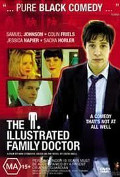
Directed by
Kriv Stenders
100 minutes
Rated M
Reviewed by
Bernard Hemingway

The Illustrated Family Doctor
Synopsis: Gary Kelp ( Samuel Johnson) works condensing books for the general reader. His current project is The Illustrated Family Doctor but the recent death of his father has made him hypersensitive to the messages of mortality the tome implies and not only does he start to develop psychosomatic symptoms but his life starts falling to pieces around him.There is much to like in this black comedy (imagine The Office meets The Singing Detective with an ambient techno score). Samuel Johnson is wonderfully entertaining as the hapless sad-sack, Gary, spiraling downwards into his scrofulitic personal hell. The production values are impressively skilful but understated. Make-up artist Deborah Lanser's physical transformation of Johnson is highly effective (she was nominated for an Oscar for her work on Kenneth Branagh's Mary Shelley's Frankenstein in 1993) whilst Elizabeth Mary Moore's production design is telling (the film was shot in 6 weeks almost entirely within the disused Sunbeam Factory in Campsie in Sydney's Western suburbs) and works well with Kevin Hayward's cinematography to provide a context for Gary's small odyssey. Tom Ellard's music is also important in this respect.
Many first time directors cut their teeth on a comedy and some of Stenders' attempts at humour are a little sophomoric and try-hard. There's the early scene with the Dad's corpse (evidently a dummy) that is clumsy, most of the diseases that Gary peruses on-screen are of sexual organs (what publisher would be producing such a book?) and then there's the general assumption that the main character's Job-like trials are (blackly) amusing (in this respect the film recalls Sacha Horler's eczma in John Curran's Praise, 1999). Yet if it opens inauspiciously, over time it does (how can one miss the opportunity?) grow on you and provides a reasonably entertaining, if not entirely gratifying, time at the movies, providing you have a fondness for the offbeat.
In a broader, artistic sense, where The Illustrated Family Doctor disappoints, is that it does not hang together as a narrative whole. Not that one is looking for catharsis but is coherence and completion too much to ask? Too many of the characters are under-developed or dismissed. Given that David Snell wrote the book on which the film is based and that Stenders has considerable experience as a producer of commercials and short film, this is particularly surprising. Take for example the character played by Horler. She appears at the outset of the film with an equal amount of screen space and time to Johnson. The implication is that they will be equally important to the story. Not so. She appears briefly on a couple more occasions over the film's duration but to no effect. What happened to Dad's corpse? Did Gary put it in his fridge? After a few perfunctory scenes Gary's girlfriend, Jennifer (Kestie Morassi) simply evaporates from his life. Why was she in it in the first place? Other characters such as the surreally sociopathic Snapper Thompson (Paul Sonkkila) are over-exposed, the shock value of his initial appearance being wantonly dissipated.
There is a scene in which Ray (Colin Friels) explains to Gary that the art of condensing a novel is about cutting out anything not pertinent to the main story, minor characters included. This can hardly not be taken ironically given the aesthetic standing of such "digested" works, and moreover, as Stenders is digesting his own novel here, self-referentially.
Yet isn't the problem then that if this principle is incorporated into the film being made, witty as that may appear to the makers, it will be comparably wanting for its audience. This is indeed exactly the effect that has resulted here. Yes, one gets the core idea, the redemption of the central character and all that, but when this is achieved by dissociating that character from his surroundings and relationships there is nothing in this trajectory for an audience with bosses, spouses, family and other such unavoidable stresses to find convincing and few people are going to laugh themselves sick over a hero with a skin disease.

Want more about this film?


Want something different?




